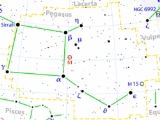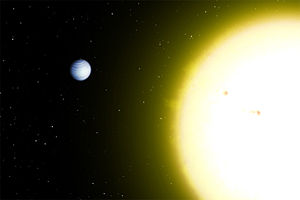
51 Pegasi
Encyclopedia
51 Pegasi is a Sun
-like star located 15.6 parsec
s (50.9 light-year
s) from Earth
in the constellation
Pegasus
. It was the first Sun-like star
, other than the Sun, found to have a planet
orbit
ing it (the first exoplanets at all were dicovered in 1992 by Aleksander Wolszczan
around pulsar PSR 1257), a discovery that was announced in 1995.
The exoplanet
's discovery was announced on October 6, 1995, by Michel Mayor
and Didier Queloz
. The discovery was made with the radial velocity method
at the Observatoire de Haute-Provence, using the ELODIE spectrograph
.
5.49, and so is visible from the Earth with binoculars, or with the naked eye under dark sky conditions. 51 Pegasi is a yellow dwarf star
estimated to be 6.1–8.1 billion years old, somewhat older than the Sun
, 4–6% more massive, with more metal
content and running low in hydrogen
. Its spectral type is listed as either G2.5IVa or G4-5Va. In 1996 astronomers Baliunas, Sokoloff, and Soon measured a rotational period of 37 days for 51 Pegasi.
 After the announcement, on October 12, 1995, confirmation came from Dr. Geoffrey Marcy
After the announcement, on October 12, 1995, confirmation came from Dr. Geoffrey Marcy
from San Francisco State University
and Dr. Paul Butler
from the University of California, Berkeley
using the Hamilton Spectrograph at the Lick Observatory
near San Jose
in California
.
51 Pegasi b
(51 Peg b) is the first, and so far only, discovered planetary-mass companion of its parent star. (Further such companions would be designated c, d, and so on.) The planet has been informally named Bellerophon. After its discovery, many teams confirmed its existence and obtained more observations of its properties, including the fact that it orbits very close to the star, suffers estimated temperatures around 1200°C, and has a minimum mass about half that of Jupiter
. At the time, this close distance was not compatible with theories of planet formation
and resulted in discussions of planetary migration
.
Sun
The Sun is the star at the center of the Solar System. It is almost perfectly spherical and consists of hot plasma interwoven with magnetic fields...
-like star located 15.6 parsec
Parsec
The parsec is a unit of length used in astronomy. It is about 3.26 light-years, or just under 31 trillion kilometres ....
s (50.9 light-year
Light-year
A light-year, also light year or lightyear is a unit of length, equal to just under 10 trillion kilometres...
s) from Earth
Earth
Earth is the third planet from the Sun, and the densest and fifth-largest of the eight planets in the Solar System. It is also the largest of the Solar System's four terrestrial planets...
in the constellation
Constellation
In modern astronomy, a constellation is an internationally defined area of the celestial sphere. These areas are grouped around asterisms, patterns formed by prominent stars within apparent proximity to one another on Earth's night sky....
Pegasus
Pegasus (constellation)
Pegasus is a constellation in the northern sky, named after the winged horse Pegasus in Greek mythology. It was one of the 48 constellations listed by the 2nd century astronomer Ptolemy, and remains one of the 88 modern constellations.-Stars:...
. It was the first Sun-like star
Solar analog
Solar-type, solar analog, and solar twin stars are those stars that are particularly similar to the Sun. The classification is a hierarchy with solar twin being most like the Sun followed by solar analog and then solar-type...
, other than the Sun, found to have a planet
Planet
A planet is a celestial body orbiting a star or stellar remnant that is massive enough to be rounded by its own gravity, is not massive enough to cause thermonuclear fusion, and has cleared its neighbouring region of planetesimals.The term planet is ancient, with ties to history, science,...
orbit
Orbit
In physics, an orbit is the gravitationally curved path of an object around a point in space, for example the orbit of a planet around the center of a star system, such as the Solar System...
ing it (the first exoplanets at all were dicovered in 1992 by Aleksander Wolszczan
Aleksander Wolszczan
Aleksander Wolszczan is a Polish astronomer. He is the co-discoverer of the first extrasolar planets and pulsar planets.- Scientific career :...
around pulsar PSR 1257), a discovery that was announced in 1995.
The exoplanet
Extrasolar planet
An extrasolar planet, or exoplanet, is a planet outside the Solar System. A total of such planets have been identified as of . It is now known that a substantial fraction of stars have planets, including perhaps half of all Sun-like stars...
's discovery was announced on October 6, 1995, by Michel Mayor
Michel Mayor
Dr. Michel G. E. Mayor is a Swiss astrophysicist and professor emeritus at the University of Geneva's Department of Astronomy. He formally retired in 2007, but remains active as a researcher at the Observatory of Geneva...
and Didier Queloz
Didier Queloz
Didier Queloz is a Geneva-based astronomer with a prolific record in finding extrasolar planets. He is understudy to Michel Mayor.Didier Queloz was a Ph.D...
. The discovery was made with the radial velocity method
Doppler effect
The Doppler effect , named after Austrian physicist Christian Doppler who proposed it in 1842 in Prague, is the change in frequency of a wave for an observer moving relative to the source of the wave. It is commonly heard when a vehicle sounding a siren or horn approaches, passes, and recedes from...
at the Observatoire de Haute-Provence, using the ELODIE spectrograph
ELODIE spectrograph
ELODIE was an echelle type spectrograph installed at the Observatoire de Haute-Provence 1.93m reflector in south-eastern France for the . Its optical instrumentation was developed by André Baranne from the Marseille Observatory. The purpose of this instrument was extrasolar planet detection by the...
.
Properties
The star is of apparent magnitudeApparent magnitude
The apparent magnitude of a celestial body is a measure of its brightness as seen by an observer on Earth, adjusted to the value it would have in the absence of the atmosphere...
5.49, and so is visible from the Earth with binoculars, or with the naked eye under dark sky conditions. 51 Pegasi is a yellow dwarf star
Dwarf star
The term dwarf star refers to a variety of distinct classes of stars.* Dwarf star alone generally refers to any main sequence star, a star of luminosity class V.** Red dwarfs are low-mass main sequence stars....
estimated to be 6.1–8.1 billion years old, somewhat older than the Sun
Sun
The Sun is the star at the center of the Solar System. It is almost perfectly spherical and consists of hot plasma interwoven with magnetic fields...
, 4–6% more massive, with more metal
Metallicity
In astronomy and physical cosmology, the metallicity of an object is the proportion of its matter made up of chemical elements other than hydrogen and helium...
content and running low in hydrogen
Hydrogen
Hydrogen is the chemical element with atomic number 1. It is represented by the symbol H. With an average atomic weight of , hydrogen is the lightest and most abundant chemical element, constituting roughly 75% of the Universe's chemical elemental mass. Stars in the main sequence are mainly...
. Its spectral type is listed as either G2.5IVa or G4-5Va. In 1996 astronomers Baliunas, Sokoloff, and Soon measured a rotational period of 37 days for 51 Pegasi.
Planetary system

Geoffrey Marcy
Geoffrey W. Marcy is an American astronomer, who is currently Professor of Astronomy at the University of California, Berkeley, famous for discovering more extrasolar planets than anyone else, 70 out of the first 100 to be discovered, along with R...
from San Francisco State University
San Francisco State University
San Francisco State University is a public university located in San Francisco, California. As part of the 23-campus California State University system, the university offers over 100 areas of study from nine academic colleges...
and Dr. Paul Butler
R. Paul Butler
R. Paul Butler is an astronomer who searches for extrasolar planets.He received a BA and an MS from San Francisco State University, completing a Master's thesis with Geoffrey Marcy, and then completed his doctoral studies at the University of Maryland, College Park in 1993...
from the University of California, Berkeley
University of California, Berkeley
The University of California, Berkeley , is a teaching and research university established in 1868 and located in Berkeley, California, USA...
using the Hamilton Spectrograph at the Lick Observatory
Lick Observatory
The Lick Observatory is an astronomical observatory, owned and operated by the University of California. It is situated on the summit of Mount Hamilton, in the Diablo Range just east of San Jose, California, USA...
near San Jose
San Jose, California
San Jose is the third-largest city in California, the tenth-largest in the U.S., and the county seat of Santa Clara County which is located at the southern end of San Francisco Bay...
in California
California
California is a state located on the West Coast of the United States. It is by far the most populous U.S. state, and the third-largest by land area...
.
51 Pegasi b
51 Pegasi b
51 Pegasi b , sometimes though unofficially named Bellerophon, is an extrasolar planet approximately 50 light-years away in the constellation of Pegasus...
(51 Peg b) is the first, and so far only, discovered planetary-mass companion of its parent star. (Further such companions would be designated c, d, and so on.) The planet has been informally named Bellerophon. After its discovery, many teams confirmed its existence and obtained more observations of its properties, including the fact that it orbits very close to the star, suffers estimated temperatures around 1200°C, and has a minimum mass about half that of Jupiter
Jupiter
Jupiter is the fifth planet from the Sun and the largest planet within the Solar System. It is a gas giant with mass one-thousandth that of the Sun but is two and a half times the mass of all the other planets in our Solar System combined. Jupiter is classified as a gas giant along with Saturn,...
. At the time, this close distance was not compatible with theories of planet formation
Planetary system
A planetary system consists of the various non-stellar objects orbiting a star such as planets, dwarf planets , asteroids, meteoroids, comets, and cosmic dust...
and resulted in discussions of planetary migration
Planetary migration
Planetary migration occurs when a planet or other stellar satellite interacts with a disk of gas or planetesimals, resulting in the alteration of the satellite's orbital parameters, especially its semi-major axis...
.
See also
- PSR 1257+12
- 55 Cancri55 Cancri55 Cancri , also cataloged Rho1 Cancri or abbreviated 55 Cnc, is a binary star approximately 41 light-years away from Earth in the constellation of Cancer...
- 70 Virginis70 Virginis70 Virginis is a yellow dwarf star approximately 59 light-years away in the constellation Virgo. It is rather unusually bright for its spectral type and may be just starting to evolve into the subgiant phase....
- 47 Ursae Majoris47 Ursae Majoris47 Ursae Majoris is a solar analog, yellow dwarf star approximately 46 light-years away from Earth in the constellation of Ursa Major. , it has been confirmed that three Jupiter-like extrasolar planets orbit the star...
- Upsilon AndromedaeUpsilon AndromedaeUpsilon Andromedae is a binary star located approximately 44 light-years away from Earth in the constellation Andromeda. The primary star is a yellow-white dwarf star that is somewhat younger than the Sun...
- Tau BoötisTau BoötisTau Boötis is a yellow-white dwarf approximately 51 light-years away in the constellation of Boötes. The system is also a binary star system, with the secondary star being a red dwarf...
- List of extrasolar planets
- Solar twin
External links
- Extrasolar Visions: 51 Pegasi
- 51 Pegasi at SolStation.com.
- nStars database entry
- David Darling's encyclopedia

